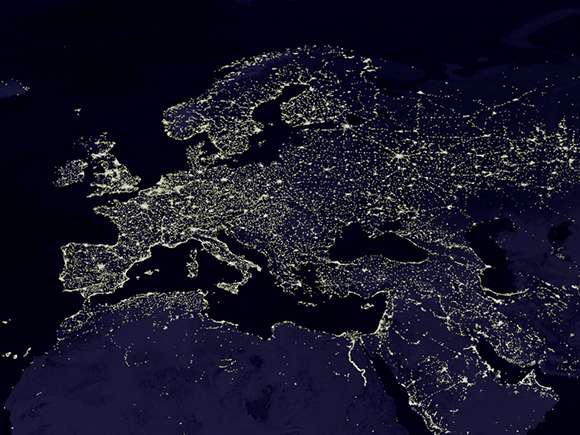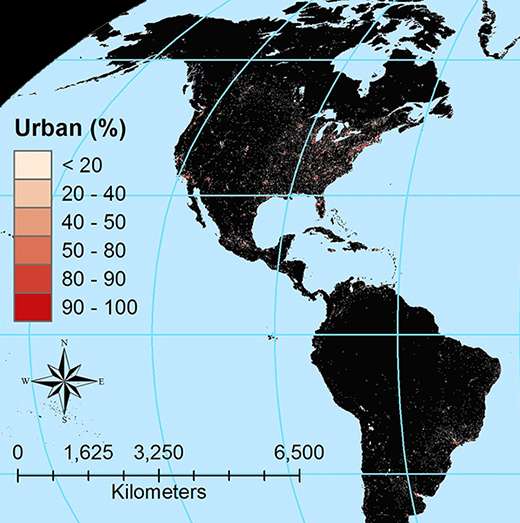Nighttime view of Earth reveals size of urban sprawl

Space-based observations of Earth provide abundant data about our world. Now, thanks to research led by Pacific Northwest National Laboratory, they can provide powerful information about how urban centers are growing worldwide. Using satellite data of nighttime light intensity, researchers developed a new method to map urbanization; that is, the increasing population concentration in urban areas.
The PNNL team working at the Joint Global Change Research Institute (JGCRI), in collaboration with University of Maryland, the National Oceanic and Atmospheric Administration (NOAA), and The Ohio State University, built a globally consistent, time-sensitive, and updateable urban extent map from nightlights data gathered from satellites about 500 miles above the Earth. Their approach is described in an article published in the journal Environmental Research Letters. Their findings reveal patterns of global urban extent from national to global scales.
"Information of urban extent and its temporal dynamics can be of great value for developing adaptation and risk management plans for infrastructure and other systems humans rely on," said Dr. Yuyu Zhou, a geography scientist at JGCRI and lead author of the paper. The JGCRI is a partnership between PNNL and the University of Maryland.
In the past 30 years, accelerating urbanization has transformed natural ecosystems. Population growth and migration mean the trend will continue. The consequences range from energy and transportation to environmental and socio-economic impacts. Expanding urban areas put pressure on water sources and use, energy requirements and the amount of carbon released, and the amount of carbon taken up by the ecosystem. Understanding these interactions is essential to tackle the consequences of global change.
Providing accurate and consistent information to enable that understanding depends on the ability to gather information on the distribution and extent of urban areas. In this study, PNNL scientists developed a new method to build a globally consistent and temporally updateable urban extent map from the nightlights data in an efficient and cost-effective way.

"By detecting and mapping urban growth extent, we can help understand global environmental changes and their impacts on natural ecosystems, people, and infrastructure," said Zhou.
In previous work, the PNNL research team, with collaborators from the University of Maryland, NOAA, and The Ohio State University developed a new method to map urban areas using the night sky light intensity measured by satellites. (See sidebar "Data Sources.") In this new work, they developed a computational method (parameterization) to estimate the key parameters in the previous cluster-based method, and used it to extend the method to the global domain. Based on the cluster-based method and newly developed parameterization approach applied to the nightlights satellite data, they constructed a new global urban area map divided into 1-km sections.
Scientists will extend the developed method over 20 years to build a consistent global urban map series and evaluate the global urbanization changes over time to understand their global environmental impact.
More information: "A Global Map of Urban Extent from Nightlights." Environmental Research Letters 10(5): 054011. DOI: 10.1088/1748-9326/10/5/054011
Journal information: Environmental Research Letters
Provided by Pacific Northwest National Laboratory


















